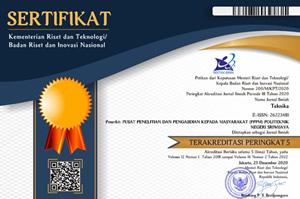ADSORPSION OF TSS AND PHENOL LEVELS ON SONGKET INDUSTRIAL WASTE WATER USING TEA DREGS AS ADSORBENT
Keywords:
Tea Dregs, adsorbents, Batch ProcessAbstract
The activities of textile industry is often pollute the surrounding environment. It also occurs in industrial of Palembang Weaving Songket. It influences the acidity and colored of the water. To manage this condition, the colored wastewater using adsorbents that absorbed from tea dregs. This study aimed to determine the effect of tea dregs adsorbent for wastewater quality improvement Songket industry. The Method of treatment of wastewater is used Batch system, which the wastewater is placed in a container by adding the adsorbent from the dregs of tea. The used of variable is the absorption time for 2 hours, 4 hours, and 6 hours, with the composition of adsorbent mass 5 gr, 10 gr, and 15 gr. Tea dregs that used in this study has the 19.26% of hemicellulose, 39.54% of cellulose and lignin 20%. It takes four hours for the research in order to obtain maximum results, with tea dregs adsorbent composition that produces a TSS content of 14 mg / L, and phenol levels 0,000 mg / L. Therefore, absorbent from the dregs of tea is very useful for the development of the textile industry, especially for Songket industrials.Downloads
Download data is not yet available.
References
Atkins PW. 1994. Physical Chemistry. Ed ke-5. England: Oxford Univ Pr.
Atmaji P., Wahyu P., dan Edi P., 1999, Daur Ulang Limbah Hasil Pewarnaan Industri Tekstil, Jurnal Sains dan Teknologi Indonesia. Vol.1, No.4.
Balai Besar Tekstil. 2005. Penggunaan Larutan Sisa Pencelupan. Bandung: balai Besar Tekstil.
Fiberti E. 2002. Pengaruh benberapa tingkat penggunaan ampas teh dalam ransum bentuk pellet terhadap performan kelinci persilangan lepas sapih. Skripsi Bogor: Fakultas Peternakan, Institut Pertanian Bogor.
Forlink. 2000. Paket terapan produksi bersih pada industri tekstil. http://www.forlink. dml.or.id/pterapb/te. html diakses pada tanggal 22 Feb 2013.
Gubernur. 2012. Peraturan Mengenai Baku Mutu Limbah Cair Industri Tekstil. No. 6. Sumatra Selatan.
Lynch CT. 1990. Practical Handbook of Material science. Ed ke-2. New York: CRC Pr.
Mahvi AH, Naghipour D, Vaezi F, Nazmara S. 2005. Teawaste as an adsorben for heavy metal removal from industrial wastewaters. Am J App Sci 2(1):372- 375. 21372-375.pdf diakses 22 Feb 2013.
Nurcahyani, E. P., Sutrisno, C. I., Surahmanto. 2006. Utilitas Ampas Teh yang Difermentasi dengan Aspergillus niger di dalam Rumen. Jurnal Protein: Fakultas Peternakan, Universitas Diponegoro.
Puspa, Endar. 2000. Potensi Bentonit Sebagai Penjernihan Minyak Goreng Bekas. Bandung.
Satake M, Nagahiro T. 1990. Modern Dictionary Physical Chemistry. New Delhi: Discovering.
Soilfoodweb. 2001. Compost tea defined. http//www.soilfoodweb.com diakses pada tanggal 20 Feb 2013
Atmaji P., Wahyu P., dan Edi P., 1999, Daur Ulang Limbah Hasil Pewarnaan Industri Tekstil, Jurnal Sains dan Teknologi Indonesia. Vol.1, No.4.
Balai Besar Tekstil. 2005. Penggunaan Larutan Sisa Pencelupan. Bandung: balai Besar Tekstil.
Fiberti E. 2002. Pengaruh benberapa tingkat penggunaan ampas teh dalam ransum bentuk pellet terhadap performan kelinci persilangan lepas sapih. Skripsi Bogor: Fakultas Peternakan, Institut Pertanian Bogor.
Forlink. 2000. Paket terapan produksi bersih pada industri tekstil. http://www.forlink. dml.or.id/pterapb/te. html diakses pada tanggal 22 Feb 2013.
Gubernur. 2012. Peraturan Mengenai Baku Mutu Limbah Cair Industri Tekstil. No. 6. Sumatra Selatan.
Lynch CT. 1990. Practical Handbook of Material science. Ed ke-2. New York: CRC Pr.
Mahvi AH, Naghipour D, Vaezi F, Nazmara S. 2005. Teawaste as an adsorben for heavy metal removal from industrial wastewaters. Am J App Sci 2(1):372- 375. 21372-375.pdf diakses 22 Feb 2013.
Nurcahyani, E. P., Sutrisno, C. I., Surahmanto. 2006. Utilitas Ampas Teh yang Difermentasi dengan Aspergillus niger di dalam Rumen. Jurnal Protein: Fakultas Peternakan, Universitas Diponegoro.
Puspa, Endar. 2000. Potensi Bentonit Sebagai Penjernihan Minyak Goreng Bekas. Bandung.
Satake M, Nagahiro T. 1990. Modern Dictionary Physical Chemistry. New Delhi: Discovering.
Soilfoodweb. 2001. Compost tea defined. http//www.soilfoodweb.com diakses pada tanggal 20 Feb 2013
Published
2015-07-29
Issue
Section
Articles













